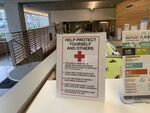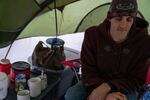It's near the top of the CDC's list of ways to steer clear of COVID-19: Avoid close contact with people who are sick.
Or, in reverse: If you’re sick, go home.
But for the 4,000 Portlanders with no bedroom of their own, finding space to recuperate — or stay away from those showing symptoms — is no easy feat.
Take Doreen’s Place, located on the ground floor of downtown Portland’s Bud Clark Commons. The shelter fits 90, tightly. Men sleep in rows of bunk beds, four deep, with about three feet of space between them. The beds are bolted to the floor and confined by partial walls.
Ideal for a bit of privacy and access to wall outlets. Less suitable for social distancing.

Stacy Borke, the senior director of programs for Transition Projects Inc., looks at the beds in Doreen’s Place, a shelter in downtown Portland. The county has asked shelters to try and create a six foot buffer around the beds of sick guests.
Rebecca Ellis / OPB
“It’s a setup like we used to have [with] the old barracks in the service,” said Deon, who sleeps in one of the shelter’s 45 beds reserved for people who’ve served in the military. “So the veterans are used to this type of sleeping arrangement.”
Like many experiencing homelessness, Deon, who asked to go by just his first name, is particularly vulnerable to the coronavirus. He’s on the older side — he’ll turn 50 this month. And he suffers from a chronic medical condition, a lung disease that makes it difficult to breathe. Those are both factors that seem to put people at higher risk of severe symptoms. Plus, he says the air he breathes in Doreen’s Place reminds him of that on an airplane: circulating through a lot of people other than him.
After the first Oregon coronavirus case was confirmed two weeks ago, county officials rushed into a series of meetings to get ahead of what could be a potentially devastating explosion among the region's homeless, who are, by and large, older, sicker and in tighter quarters than the rest of the population.
The resulting guidance asked shelter providers to attempt to space out the beds of anyone displaying symptoms of the virus — coughing, fever, shortness of breath — by six feet. Like the flu, that's the farthest distance the coronavirus is thought to travel from person to person.
County officials are making other requests, too: They’re asking shelter providers to give people with a “new, worse, or different” cough masks, to post signage about proper sneeze etiquette and to more frequently scrub doorknobs, faucets and keyboards.
Shelter providers say these suggestions are easily doable — and, in most cases, are already underway. Signs urging residents to wash their hands vigorously are fixtures in many a shelter entryway. Some places now break out the bleach wipes hourly.
But finding the room to space out the sick from the healthy in shelters, many of which are specifically designed to fit as many people as possible, will take more time. It’s unclear how long.
“This is what's kind of stumping many providers,” said Stacy Borke, the senior director of programs for Transition Projects Inc., which runs Doreen’s Place. “A recommendation of six feet between beds is … it's … it's so much greater than the actual bed spacing.”
With 810 beds spread out over nine shelters, Transition Projects is the largest provider of shelter services in the region. Borke says each facility presents its own design quirks that make it difficult, if not impossible, to simply drag a bed a little farther away.
“All ideas are on the table and welcome,” Borke said. “I think creativity is certainly an option.”
Borke said the best strategy right now is to create more room by sheltering fewer people.
As of last week, Transition Projects has temporarily stopped taking in new guests across their shelters. That means when someone like Deon, who recently found housing in Southwest Portland, leave the shelter, the beds won’t be filled behind them.
Transition Projects is not the only provider bringing intake to a sudden halt.
In Human Solutions’ Gresham women’s shelter, people are currently spaced two to three feet apart. Marci Cartagena, the nonprofit’s emergency services director, said they’re hoping to cut down by 15 to 20 beds by the end of the month. Until then, no new clients will be coming into that shelter or another in Southeast Portland.
Do Good Multnomah, which operates a shelter for veterans, says their layout in a converted office space gives them a little more leeway. Spokesperson Kim Hunt said last week they were hoping to bring their numbers down by five in order to create a quarantine room.

A sign in the entryway of downtown Portland's Bud Clark Commons. The building offers apartments for people who have experienced homelessness as well as a 90-bed shelter on the ground floor.
Rebecca Ellis / OPB
To counteract the effect this could have in a city with unrelenting demand for shelter beds, county spokesperson Denis Theriault said they’re planning on keeping open two winter shelters: one run out of a church in North Portland and the other out of the basement of a county building downtown. Theriault says this will keep an extra 125 beds in the system that usually disappear by springtime.
Motels are another partial solution. Tuesday evening, the county told shelters they could increase their use of motel vouchers to rehouse sick people who won’t wear a mask. These are people the county had previously advised providers to remove from their facilities and would otherwise be left sick on the street.
Shelters also have “limited discretion” to use these vouchers on people who are elderly and chronically sick, though Theriault notes there are constraints as to how many vouchers can be used.

About half of Portland's homeless population live outside, many clustered in campsites. These areas pose unique risks when it comes to preventing an outbreak of the novel coronavirus.
Jonathan Levinson / OPB
Sanitizing and spacing out shelter beds offers partial protection only to half of those experiencing homelessness: The other 51% of Portland's homeless population sleep outside, many clustered in isolated campsites.
These areas pose their own challenges.
Sinks, for example, are hard to come by. Lisa Hawash, an associate professor of practice at Portland State University who has studied the city's lack of hygiene facilities for the homeless, says options are limited to the Portland Loos, social services organizations during the workday, or a lenient business. (Of course, not all are. A Starbucks in Old Town Chinatown recently stopped giving out the bathroom code because the numbers were "getting around the neighborhood.")
Misinformation can swirl. Interviews with those experiencing homelessness turned up rumors that the number of Oregon’s cases have mounted to 500 and that a nationwide quarantine was imminent. Others had never heard of the virus.
And, just like the shelters, there’s not a lot of extra space. A tent can work for social distancing — but only if you’re the only one in it.
Cities and counties are trying to find solutions to these challenges. Portland is in the process of installing seven new portable toilets and 25 hand-washing stations. Multnomah County is organizing a massive outreach push to hand out blankets, hand sanitizer, masks and informational cards on the virus. Theriault says the effort is akin to a point-in-time count, where providers fan out across the county to tally the number of people experiencing homelessness on a single night.
And the county's making a familiar ask of people living in the camps: If you're sick — and can't find a different tent — try to create a six-foot buffer.
But some sleeping outdoors say that’s potentially asking too much of people living in a space barely wide enough to stretch out your arms.
“A lot of us out here in these camps, we camp as a group — we’re never six feet apart,” said Raven Drake, who’s been living at a campsite on the Western bank of I-5 in North Portland for the last few months. “That's just unrealistic.”
While she has a tent to herself, about a mile down the hill, she says as many as nine people cram into six-person tents.

Raven Drake has been living at a campsite on the Western bank of I-5 in North Portland for the last few months. She’s set aside a second tent to isolate sick people with light symptoms.
Jonathan Levinson / OPB
Drake has a medical background: an obsession with her older sister’s nursing textbooks followed, she said, by five years as a combat medic in the U.S. Navy. So when Multnomah County leaders held brainstorm meetings last week, Kaia Sand, who heads the local advocacy group Street Roots, brought Drake along.
At the meeting, Drake said she told officials what campsites such as hers needed to prevent an outbreak: access to bathrooms, showers, water and hand sanitizer.
But when it comes to carving out space, that’s something Drake’s taking into her own hands. She’s set aside a second tent — one usually used for cooking and socializing — to isolate sick people with light symptoms.
She has blankets, tea, water and the business cards of physicians to call if a patient’s condition doesn’t improve.
“It just sort of gives us space to be able to bring people to allow them to recuperate,” she said, noting most people who catch the virus display only mild symptoms. “And so, for most people, the best thing they could do is get rest, drink electrolytes and water, and allow this to run its course.”
